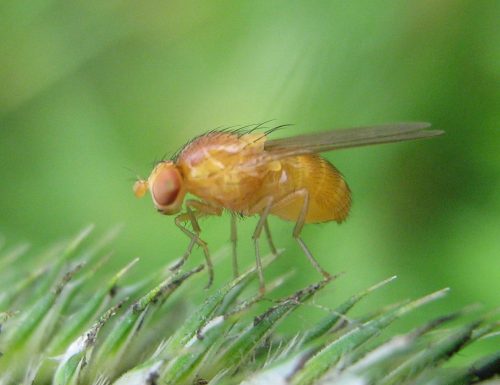There are only three kinds of organisms known to have wings that are functional for flights—birds, insects, and bats. Even today, wings are often thought of as nothing more than appendages allowing organisms to fly. However, in Drosophila melanogaster (fruit flies), wings serve much more complex purposes. A few decades ago, the D. melanogaster wing was proposed to be a taste organ, but recent research has shown that it may also play a role in chemoreception, a physiological process by which organisms can send and respond to chemical stimuli. The taste organ of fruit flies contains several classes of receptors that help detect chemical signals, such as IR52c and IR52d. Sensilla, a type of sensory receptor, was analyzed from the anterior wing margin of fruit flies. Professor John Carlson and his team at Yale discovered that one gene, ionotropic receptor (IR)52a, was co-expressed with markers of sexual circuitry in sensilla neurons.
Why the concern with chemical stimuli? Mating is central to biology; it determines whether or not generations of different species will be produced and whether or not certain organisms will go extinct. To reproduce, most organisms, including fruit flies, require a suitable mating partner. During mating, an organism will secrete pheromones, chemical signals, to evoke a social response in members of the same species.
Although scientists have identified several candidate pheromone receptors in Drosophila, there are many that have yet to be identified. The goal is to identify and receptors that narrate sexual circuits.
Scientists generated IR52a deletions using CRISPR/Cas9 homologous recombination and all flies were collected within six hours after emerging from the pupal case. The team carried out RNA-sequencing analysis and dye transfer experiments in sensilla negative wild-type wings and in sensilla negative mutant wings to confirm whether pheromones from one fly can be transmitted to the wing margin of another fly. IR52a was one of the genes identified to be involved in pheromonal response. One unique feature of this gene is that the activation of IR52a positive neurons not only activates a circuit that drives male sexual behavior towards females of the same species but also toward males and females of different species.
Carlson found that IR52a, found on both the Drosophila wings and legs, is required for both male and female mating behavior. Mutant IR52a males showed major delays in reproduction and mutant IR52 females had significantly less copulation with their male counterparts. In addition, the IR52 gene transcends the species barrier; when high levels of the gene were expressed in female D. melanogaster, the wings were extended by an additional fifteen percent towards that of a distantly related species, D. suzukii. “We were really surprised to see that the activation of IR52a neurons can drive a male fly over the species barrier. We were also very surprised to find that IR52a neurons can override the circuitry that normally suppresses sexual behavior in previously mated female flies,” Carlson said.
The Carlson Lab confirmed that the curved sensilla on D. Melanogaster wings margin contain pores and it has been discovered that at least six hundred and fifty genes were expressed at higher levels in wings that contain chemosensory sensilla. The RNA-seq analysis also revealed other interesting genes that are expressed in different kinds of sensilla in fly wings. It is possible that a portion of these genes may provide information about other fly functions. Although IR52a positive neurons affect sexual circuits in the fly and not humans, its ability to drive sexuality beyond sex and species allow us to question the role of sensory cues in activating sexual circuits. “Identification of suitable mating partners is a fundamental problem in biology,” Carlson said.

